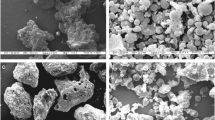Abstract
Use of fly ash locked in the ash ponds in geotechnical applications such as stowing or backfilling of the mines is an attractive alternative to solve the disposal problem. Before it is used as a stowing or backfilling material, the response of the fly ash to imposed load must be determined in order to assess its load taking ability. The present study examines the effect of time and incremental load on the consolidation characteristics of the sedimented stowed pond ash using a fixed ring consolidometer. The important parameters, viz. rate of settlement, consolidation coefficients and void ratio, etc. of the hydraulically stowed pond ash collected after 7, 14, 21, 28 and 35 days of stowing under step incremental loads are determined. The study revealed that 60.42–84.87% settlement of the sedimented stowed pond ash takes place in the initial 1 min of the loading. In addition, it is observed that the coefficient of consolidation of the sedimented stowed pond ash, which varies in the range of 0.0195–0.1882 cm2/min, is comparatively low and decreases with the increment of applied load and time. This indicates that the structures lying above the stowed pond ash mass will undergo gradual settling and not suffer large deformation.









Similar content being viewed by others
References
Ahmaruzzaman M (2010) A review on the utilization of fly ash. Prog Energy Combust Sci 36(3):327–363
American Society for Testing and Materials (ASTM) (2003) Standard specification for coal fly ash and raw or calcined natural pozzolan for use concrete. Designation C618-03
American Society for Testing and Materials (ASTM) (2006) Standard test method for permeability of granular soils (constant head). Designation D2434-68
Aysen A (2002) Soil mechanics: basic concepts and engineering applications, chap 6. Taylor & Francis, London, pp 213–259
Capco (1990) Pulverized fuel ash as a reclamation fill. Report, China Light and Power Co. Ltd., Hong Kong, pp 1–34
Dhawan S, Mishra A, Rao S (2007) Experimental study on shrinkage behaviour and prediction of shrinkage magnitudes of residual soils. In: Experimental unsaturated soil mechanics, Springer Proceedings Physics, vol 112(V), pp 277–284
Indraratna B (1996) Utilization of lime, slag and fly ash for improvement of a colluvial soil in New South Wales, Australia. Geotech Geol Eng 14:169–191
IS: 2720 (Part 15) (1986) Determination of consolidation properties. Methods of test for soils: part 15. Bureau of Indian Standards, New Delhi
Jakka RS, Ramana GV, Datta M (2010) Shear behaviour of loose and compacted pond ash. Geotech Geol Eng 28:763–778
Kaniraj SR, Gayathri V (2004) Permeability and consolidation characteristics of compacted fly ash. J Energy Eng 130(1):18–43
Kim B, Prezzi M (2008) Evaluation of the mechanical properties of class-F fly ash. Waste Manage 28(3):649–659
Kim B, Prezzi M, Salgado R (2005) Geotechnical properties of fly and bottom ash mixtures for use in highway embankments. J Geotech Geoenviron Eng 131(7):914–924
Madhyannapu RS, Madhav MR, Puppala AJ, Ghosh A (2008) Compressibility and collapsibility characteristics of sedimented fly ash beds. J Mater Civil Eng 20(6):401–409
Major JJ (2000) Gravity-driven consolidation of granular slurries—implications for debris-flow deposition and deposit characteristics. J Sed Res 70(1):64–83
McLaren RJ, Digioia AM Jr (1987) The typical engineering properties of fly ash. In: Proceedings geotechnical practice for waste disposal,’ 87. Geotechnical special publication, no. 13. ASCE, New York, pp 683–697
Mishra DP, Das SK (2008) Compaction and consolidation behaviour of fly ash and pond ash for stowing in underground mines. MGMI Trans 104(1&2):55–72
Mishra DP, Das SK (2010) A study of physico-chemical and mineralogical properties of Talcher coal fly ash for stowing in underground coal mines. Mater Charact 61:1252–1259
Moghal AAB, Sivapullaiah PV (2011) Effect of pozzolanic reactivity on compressibility characteristics of stabilised low lime fly ashes. Geotech Geol Eng 29(5):665–673
Muhardi A, Marto A, Kassim KA, Makhtar AM, Wei LF, Lim YS (2010) Engineering characteristics of Tanjung Bin coal ash. Electron J Geotech Eng 15(Bund. K):1117–1129
Pandian NS (2004) Fly ash characterization with reference to geotechnical applications. J Indian Inst Sci 84:189–216
Pandian NS, Balasubramonian S (1999) Permeability and consolidation behavior of fly ashes. J Test Eval 27(5):337–342
Piper CS (1950) Soil and plant analysis. The University of Adelaide, Adelaide
Porbaha A, Pradhan TBS, Yamane N (2000) Time effect on shear strength and permeability of fly ash. J Energy Eng 126(1):15–31
Prashanth JP, Sivapullaiah PV, Sridharan A (2001) Pozzolanic fly ash as a hydraulic barrier in land fills. Eng Geol 60:245–252
Temimi M, Rahal MA, Yahiaoui M, Jauberthie R (1998) Recycling of fly ash in the consolidation of clay soils. Resour Conserv Recycling 24:1–6
Trivedi A, Singh S (2004) Geotechnical and geoenvironmental properties of power plant ash. Inst Eng (India) J CV 85:93–99
Tu W, Zand B, Butalia TS, Ajlouni MA, Wolfe WE (2009) Constant rate of strain consolidation of resedimented Class F fly ash. Fuel 88(7):1154–1159
Web DL, Hughes TS (1987) The consolidation characteristics of fly ash. In: Proceedings of conference on ash, a valuable resource. CSIR, Pretoria
Yudhbir N, Honjo Y (1991) Applications of geotechnical engineering to environmental control. In: Proceedings of ninth Asian regional conference on soil mechanics and foundation engineering, Bangkok, vol 2, pp 431–469
Acknowledgments
The present study is based on the R&D project sponsored by TIFAC, New Delhi, an autonomous wing of the Department of Science and Technology (DST), India. The authors wish to express their gratitude both to TIFAC for financial support and the authority of Talcher Thermal Power Station of NTPC, India for supplying the pond ash to carry out the experiments. The Central Research Facility Centre of IIT, Kharagpur is also gratefully acknowledged for providing the necessary facilities for conducting the XRD and SEM analysis.
Author information
Authors and Affiliations
Corresponding author
Rights and permissions
About this article
Cite this article
Mishra, D.P., Das, S.K. One-Dimensional Consolidation of Sedimented Stowed Pond Ash. Geotech Geol Eng 30, 685–695 (2012). https://doi.org/10.1007/s10706-011-9486-x
Received:
Accepted:
Published:
Issue Date:
DOI: https://doi.org/10.1007/s10706-011-9486-x




